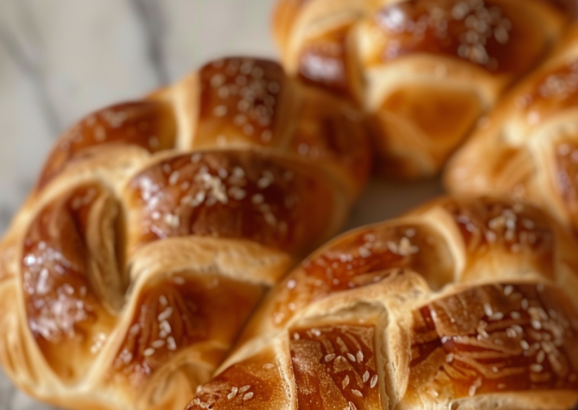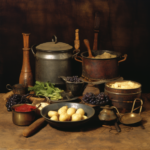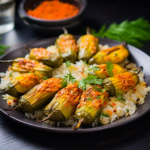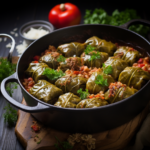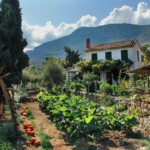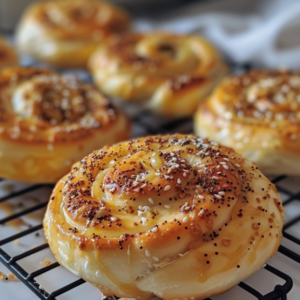
Have you ever wondered about the secrets behind the mouthwatering Greek pastries and breads that make your taste buds dance with joy? In this article, we will take you on a delightful journey through the art of Greek baking techniques. Prepare to discover the ancient traditions and innovative methods used by Greek bakers to create the most delicious treats. From the aromatic herbs and spices grown in the diverse regions of Greece to the careful mastery of dough, we will delve into the world of Greek baking and unlock the secrets that make it truly unique. So, grab a cup of Greek coffee, sit back, and get ready to immerse yourself in the captivating realm of Greek baking.
Overview of Greek baking
Introduction to Greek baking
Greek baking is an integral part of the country’s culinary traditions, known for its rich flavors, delicate pastries, and hearty breads. From its historical background to the influence it has had on Mediterranean cuisine, Greek baking holds a special place in the hearts and stomachs of people around the world.
Historical background
Greek baking has a long and fascinating history that dates back thousands of years. Baking in ancient Greece was closely intertwined with religious and cultural practices, with offerings to the gods often taking the form of baked goods. The art of baking has been passed down through generations, preserving traditional recipes and techniques.
Importance of Greek baking in culinary traditions
Greek baking plays a crucial role in Greek culinary traditions, bringing people together through the enjoyment of delicious food. It is a reflection of the country’s cultural heritage and a way to preserve its unique flavors and techniques. Greek baking techniques have also been widely adopted and incorporated into other cuisines around the world.
Ingredients used in Greek baking
Flour varieties
Greek baking relies heavily on different types of flour, each contributing its own unique texture and flavor to the final product. From the classic all-purpose flour used in many breads and pastries to specialty flours like semolina, chickpea flour, and cornmeal, Greek baking offers a wide range of options.
Dairy products
Dairy products, such as butter, milk, and yogurt, are essential ingredients in Greek baking. They add richness and moisture to cakes, breads, and pastries, resulting in irresistible treats. Feta cheese and other types of cheese are also commonly used in savory baked goods, adding a tangy and creamy element to dishes.
Sweeteners
Honey and sugar are the primary sweeteners in Greek baking. Honey, in particular, holds a special place in Greek cuisine, with its distinct flavor and versatility. It is used not only as a sweetener but also as a glaze or syrup to moisten and enhance the texture of various desserts.
Nuts and seeds
Nuts and seeds are prevalent in Greek baking, adding depth of flavor and crunch to many dishes. From walnuts and almonds to sesame seeds and pine nuts, these ingredients are often used in both sweet and savory baked goods, providing a satisfying texture and enhancing the overall taste.
Herbs and spices
Greek baking is known for its skillful use of herbs and spices, which bring complexity and aromatic notes to the final products. Common herbs like oregano, thyme, and rosemary are often used in savory baked goods, while cinnamon, cloves, and nutmeg are popular spices in sweet treats like baklava.
Traditional Greek baked goods
Phyllo pastry-based desserts
Phyllo pastry is a staple in Greek baking and forms the foundation of many delicious desserts. Spanakopita, a spinach and feta cheese pie wrapped in delicate layers of phyllo, is a classic example of a savory dish made with this paper-thin pastry. Sweet phyllo desserts like baklava and kataifi are also widely enjoyed for their crispy and syrup-soaked layers.
Yeasted breads and pastries
Bread holds a special place in Greek culture, and there is a wide variety of yeasted breads and pastries in Greek baking. From the iconic round loaf of crusty bread known as horiatiko psomio to fluffy and buttery tsoureki, a sweet bread often enjoyed at Easter, Greek yeasted breads showcase the expertise and love for baking.
Honey-based treats
Honey is not only a sweetener but also a star ingredient in many Greek desserts. Loukoumades, small deep-fried dough balls soaked in honey syrup and sprinkled with cinnamon, are a true indulgence. Melomakarona, honey and spice cookies topped with a walnut, are another beloved treat during festive occasions.
Savory pies and pastries
Greek baking is renowned for its savory pies and pastries, which showcase the country’s culinary creativity. Spanakopita and tiropita are popular examples, featuring layers of phyllo filled with spinach and cheese. Other savory treats include bougatsa, a creamy custard-filled pastry, and kreatopita, a meat-filled pastry.
Regional specialties
Each region of Greece has its own unique baked goods and specialties. From the delicious cheese- and egg-based Sfakianopita in Crete to the almond-filled amygdalota cookies in the Ionian Islands, Greek baking varies from place to place, reflecting the diverse landscapes and local traditions.
Greek baking techniques
Use of phyllo pastry
Phyllo pastry is an essential component of many Greek desserts, and mastering its use is a skill that Greek bakers take pride in. Thin layers of dough are carefully brushed with melted butter or oil, creating a delicate and flaky texture when baked. Shaping and handling the fragile phyllo requires precision and patience.
Kneading and proofing dough
In Greek baking, kneading the dough is a crucial step in developing gluten and creating a light and airy texture. The yeast dough is typically left to proof until it doubles in size, allowing the flavors to develop and the dough to become more manageable. This technique ensures a perfect rise and texture in breads and pastries.
Baking in traditional ovens
Traditional Greek baking often takes place in wood-fired ovens, which impart a unique smoky flavor and even heat distribution. These ovens have been used for centuries and are still cherished by many bakers. The high temperatures and radiant heat help achieve the desired golden crust and moist interior.
Honey syrup soaking
Many Greek desserts are finished with a generous drizzle of honey syrup, giving them a luscious and moist texture. The sweet syrup is made by simmering honey, water, and sometimes lemon juice or spices. The delicate art lies in soaking the finished baked goods with just the right amount of syrup to enhance the flavors without making them overly sweet.
Layering and filling techniques
Greek baking often involves intricate layering and filling techniques, especially when working with phyllo pastry. Multiple thin layers are stacked with various fillings, such as cheese, spinach, or nuts, resulting in visually stunning and flavorful creations. Precise folding and rolling are crucial to achieve the desired shapes and textures.
Shaping and scoring breads
Greek breads come in various shapes and sizes, each with its own significance and presentation. From the distinctive round loaf of village bread to the braided tsoureki, shaping and scoring play a vital role in creating an appealing appearance. These techniques not only enhance the aesthetic appeal but also contribute to the texture and crust development.
Specialty Greek baking equipment
Wood-fired ovens
Wood-fired ovens are the traditional baking equipment used in Greek households and bakeries. These ovens provide the perfect environment for achieving crispy crusts and even bakes. The smoky flavor imparted by the wood fire adds an extra layer of depth to the baked goods, making them truly authentic.
Marble working surfaces
Marble surfaces are highly valued in Greek baking, especially for working with delicate doughs like phyllo. The cool surface helps prevent the dough from sticking and provides an ideal workspace for shaping and stretching the dough. The smoothness of the marble surface is also believed to contribute to the overall quality of the finished product.
Pastry brushes
Pastry brushes are essential tools in Greek baking for generously brushing the delicate phyllo pastry with melted butter or oil. These brushes come in various sizes and materials, ensuring precise control and even distribution of the butter or oil, resulting in a beautiful golden color and a flaky texture.
Baking molds and pans
Baking molds and pans come in a variety of shapes and sizes, catering to the diverse range of Greek baked goods. From round cake pans to square pie molds, these specialized tools ensure even baking and attractive presentation. Traditional copper or tin-lined pans are highly prized for their heat conductivity and ability to achieve the desired textures.
Traditional rolling pins and tools
Greek baking often utilizes traditional rolling pins and tools made from wood or marble. These tools allow for precise shaping and stretching of dough, particularly when working with phyllo. The familiar weight and feel of these traditional tools are cherished by Greek bakers, connecting them to the rich heritage of their craft.
Popular Greek baking recipes
Spanakopita (spinach pie)
Spanakopita is a well-loved Greek dish made with layers of phyllo pastry filled with a delicious mixture of spinach, feta cheese, onions, and herbs. The pie is baked to a golden perfection and enjoyed as a main course or as a delightful snack.
Baklava
Baklava is perhaps the most iconic Greek dessert, featuring layers of buttery phyllo pastry filled with a mixture of nuts, spices, and honey syrup. This indulgent treat is enjoyed on special occasions and is known for its crispy texture and sweet, nutty flavors.
Tiropita (cheese pie)
Tiropita is a savory pie made with layers of phyllo pastry and a delicious filling of various cheeses, such as feta and ricotta. This classic Greek dish is often enjoyed as a breakfast or as part of a mezze spread.
Koulouri (sesame bread rings)
Koulouri is a popular street snack in Greece, consisting of chewy bread rings covered in sesame seeds. These delicious rings are often enjoyed as a breakfast or a quick on-the-go snack and are loved for their crispy exterior and soft interior.
Loukoumades (honey balls)
Loukoumades are small, deep-fried dough balls soaked in honey syrup and sprinkled with cinnamon. These heavenly treats are typically served warm and are a favorite during festivals and celebrations, providing a delightful mix of textures and flavors.
Influence of Greek baking on Mediterranean cuisine
Spread of Greek culinary traditions
Greek culinary traditions have had a significant impact on Mediterranean cuisine as a whole. Through trade, migration, and colonization, Greek cooking techniques, ingredients, and flavors have spread throughout the region, shaping the culinary landscape and influencing the way people cook and eat.
Adoption of Greek baking techniques
Greek baking techniques, such as the use of phyllo pastry, layering, and honey syrup soaking, have been widely adopted by other Mediterranean cuisines. These techniques add complexity and depth to dishes, creating a unique culinary experience that transcends borders.
Incorporation of Greek flavors in other cuisines
Greek flavors, particularly the use of herbs, spices, and ingredients like feta cheese and olive oil, have found their way into various Mediterranean cuisines. The tangy and salty flavors of feta cheese, for example, can be found in dishes from Italy to Morocco, adding a touch of Greek influence to these regional favorites.
Health benefits of Greek baked goods
Use of Mediterranean ingredients
Greek baked goods often utilize ingredients that are part of the healthy Mediterranean diet. Olive oil, for instance, is often used instead of butter, providing heart-healthy fats. The use of fresh herbs and vegetables also adds a nutritious element to many Greek dishes.
Inclusion of nutritious elements
Greek baking incorporates nutritious elements, such as nuts, seeds, and dairy products, in many recipes. These ingredients provide essential vitamins, minerals, and healthy fats, contributing to a well-balanced diet.
Balanced flavors and portion sizes
Greek baked goods are known for their balanced flavors and portion sizes. The use of herbs and spices adds complexity without relying heavily on excessive sugar or unhealthy fats. Additionally, the traditional emphasis on moderation ensures that portion sizes are not overly indulgent.
Exploring Greek regional variations
Cretan baking traditions
Crete, with its fertile land and mild climate, boasts a rich baking tradition. Cretan baked goods often feature local ingredients like olive oil, honey, and herbs. Cheese pies, barley bread, and unique sweet treats like kaltsounia (cheese-filled pastries) showcase the island’s culinary heritage.
Ionian Islands specialties
The Ionian Islands are known for their diverse and delicious baked goods. From the light and flaky mandolato, a traditional nougat-like dessert, to the sweet semolina-based pastries called pastelis, these islands offer a wonderful array of unique treats.
Thessaly and Central Greece delicacies
Thessaly and Central Greece are home to a variety of mouthwatering specialties. From amphipasto, a local bread filled with olives and cheese, to diples, paper-thin fried pastries coated in honey syrup, the region’s baking traditions are diverse and vibrant.
Northern Greece baked goods
Northern Greece has its own distinct baking traditions, with a focus on hearty breads and pies. The famous bakery of Thessaloniki is known for its sesame seed-covered bagels, while the region of Macedonia is home to the delicious kourkoubinia, sweet cheese-filled pastries.
Aegean islands’ traditional treats
The Aegean islands offer a plethora of traditional treats, influenced by their unique geography and cultural heritage. From Santorini’s sweet tomato-based preserves to the almond-studded amygdalota cookies of Rhodes, each island has its own specialties that reflect the local flavors and traditions.
Modern trends in Greek baking
Innovation in flavor combinations
Greek bakers are constantly exploring new flavor combinations and pushing the boundaries of traditional recipes. From adding unique spices and herbs to experimenting with different fillings and toppings, modern Greek baking embraces innovation while staying true to its roots.
Creative twists to traditional recipes
Traditional Greek recipes are often given contemporary twists, incorporating new techniques and ingredients. For example, the classic baklava might be reinvented with the addition of chocolate or the incorporation of local fruits and nuts.
Contemporary presentation techniques
Greek baking is not only about taste but also about visually stunning creations. Modern Greek bakers are known for their artistic approach to presentation, using creative plating techniques and imaginative garnishes to make their baked goods as visually appealing as they are delicious.
In conclusion, Greek baking is a fascinating world of flavors, traditions, and techniques. From the delicate layers of phyllo pastry to the tantalizing scent of freshly baked bread, Greek baking offers a rich culinary experience deeply rooted in history and culture. Whether you’re enjoying a traditional spanakopita or savoring a contemporary twist on a classic recipe, Greek baked goods are sure to leave you with a lasting impression of warmth, hospitality, and deliciousness.
Sponsored by
Digital Marketing Company Digital Heroes Caffe and Financial Navigator 360, this page is a tribute to the long-standing tradition of Greek baking, a cherished part of Hellenic culinary heritage. The essence of Greek baking goes beyond the mere act of making bread or pastries; it’s an artistic expression, a community affair, and a celebration of cultural identity.
Relish the Flavors: Explore Our Recipes
FAQs on Greek Baking Techniques
- What is the significance of phyllo dough in Greek baking?
- Phyllo dough is a staple in Greek baking, used in both sweet and savory dishes. Its versatility is celebrated in various Greek pastries like baklava and spanakopita.
- How does the traditional Greek ‘fournos’ enhance baking?
- The wood-fired ‘fournos’ lends a unique, smoky flavor and a delightful crust to the baked goods, which is hard to replicate in modern ovens.
- What are some essential Greek baking ingredients?
- Olive oil, honey, sesame seeds, and a variety of fresh herbs and spices are quintessential in Greek baking, enriching the flavors and aromas.
- Where can I learn authentic Greek baking techniques?
- Our platform offers interactive cooking sessions led by skilled Greek chefs, like Anna-Maria Barouh, who impart the traditional techniques and secrets of Greek baking.
Join Us in Celebrating Greek Culinary Traditions
Chef on a Bike is more than a platform; it’s a haven for those enchanted by Greek culinary traditions. Our community embodies the spirit of sharing, learning, and rejoicing in the simple yet profound pleasure of creating and enjoying food. As you delve into our curated recipes, insightful articles, and interactive sessions, you’re not just learning to bake; you’re becoming part of a tradition that cherishes the essence of Greek culture in every knead, every bake, and every taste.
Embrace the world of Greek baking and let your culinary journey begin with us.






